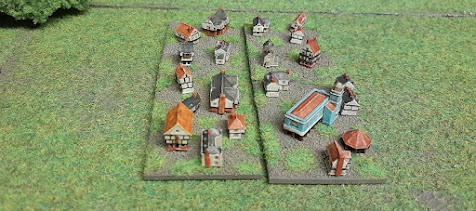With the Rejects slowly drifting back from their various holiday locations refreshed and tanned (or is that weather beaten?), it seemed like a good moment to put on a remote game.
With David, Ray, Lee, Steve and Surjit taking up the reins I decided to put on a fictitious battle set in the Austrian War of Succession between the Austrians and the French. The main purpose was to have a game that involved some fog of war. Hence the use of blinds, both real and dummy.
The rules in use were Koenig's Krieg. All figures are Baccus 6mm and the buildings are Brigade Models.
The scenario was that an Austrian
army had thrown back French defences on the Rhine. The French king, Louis XV, had ordered a counterattack near
to the small town of Les Aveugles.
Both
commanders both sides must first seek to outmaneuver each other to gain a tactical advantage.
The aim on
both sides is to force the opposing force to retreat.
The Armies
David and Ray made up the Austrian commanders. Whilst Lee, Steve and Surjit took up the challenge of the French commanders.
The forces consisted 4 brigades each hidden amongst 8 blinds made up as the following:
Austrian Army
Brigade A | 2 heavy cavalry units |
Brigade B | Cavalry dummy |
Brigade C | 2 dragoon regiments |
Brigade D | Cavalry dummy |
Brigade E | 3 infantry units and one artillery
battery |
Brigade F | Infantry dummy |
Brigade G | Infantry dummy |
Brigade H | 3 infantry units and one artillery
battery |
French Army
Brigade A |
Infantry dummy |
Brigade B |
4 infantry units and one artillery
battery |
Brigade C |
4 heavy cavalry units (small but
can be merged to create 2 normal size units). |
Brigade D |
Infantry dummy |
Brigade E |
Cavalry dummy |
Brigade F |
4 infantry units (including one
grenadier unit) and one artillery battery |
Brigade G |
2 dragoon regiments |
Brigade H |
Infantry dummy |
Initial Deployment
Both sides sent their deployment to me prior to the evening. The following photo shows how the blinds were set up on the table. You might be able to start working out possible tactics for the battle ahead.
 |
| Initial deployment. The letters on the cards represent those in the army lists above. The individual trees are just decoration. The woods are impassable to formed infantry and cavalry. |
The French commanders chose to combine their four smaller heavy cavalry into two larger regiments.
The Maneuver Phase of the Battle
Each side moved various blinds. As one blind moved into range of another it would have to reveal itself. If it was a dummy then the opponent could remain hidden. If the blind was a real brigade it would have to be deployed and the opponent would have to reveal the contents of their blind as well.
By the end of second turn of the maneuver phase the Austrian and French were moving into sight of each other. All the cards with the white and red poker chips will have to reveal themselves, with the white ones only doing so if the red ones are real brigades.
The two sides seemed to have collided.
The opposing cavalry on the near edge were close enough to all be pinned in position until the end of the maneuver phase.
At the end of the maneuver phase all the blinds not already revealed were now done so.
This is how the battlefield looked. Both sides successfully managing to squeeze their forces into a space effectively 2x2 feet.
The French, on the right had deployed their brigades better and were able to inflict some early damage on the Austrian infantry isolated in the centre. Now realising that this was a dangerously exposed place to be, David made the decision to order a withdrawal in order to redeploy.
However, what turned the brigade withdrawal into a decision to retire the whole Austrian army was the effective destruction of their heavy cavalry brigade nearest to the edge.
Analysis
An Austrian retreat was the right decision at this time. Their difficulty may well have started with the deployment of the blinds that left their infantry separated and one brigade bottlenecked behind the cavalry. However, the French were able to impose themselves on events by understanding and utilising the initiative when it came their way. In this sense, the rules provided a level of nuance to command and control that I had not fully appreciated.
Koenig Krieg used with their rules on blinds brings the opponents into a position of engagement quickly. So, careful deployment is key but poor deployment is not irretrievable.
In an age of linear warfare, the French in this instance had the line. The Austrians' struggled to achieve theirs.
Afterthought
I think that I would like to try something like this again on a bigger table 6x4ft instead of 4x4. It should make for a different game with space for flanks and scope for greater initial maneuver.
Apologies for lack of photos - I still struggle with the umpiring a remote game and recording the action. Perhaps I should rope the wife in to take the snaps?





















